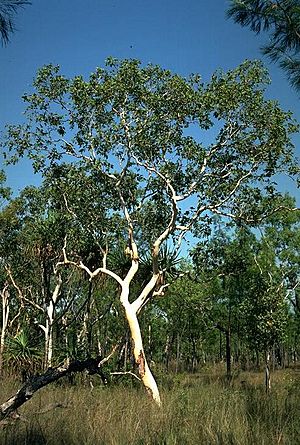Whitebark facts for kids
Quick facts for kids Whitebark |
|
|---|---|
 |
|
| Scientific classification | |
| Genus: |
Eucalyptus
|
| Species: |
apodophylla
|
The Whitebark tree, also known as Eucalyptus apodophylla, is a special kind of tree. It grows only in northern Australia. This tree is famous for its smooth, powdery white bark. It's a small to medium-sized tree. Its leaves are shaped like wide spearheads or eggs. It also has white flowers that grow in groups of seven. After the flowers, it grows fruit that looks like a half-sphere or a cone.
Contents
What the Whitebark Tree Looks Like
The Whitebark tree usually grows to be about 6 to 20 meters (20 to 66 feet) tall. It has very smooth, powdery white bark. This bark is one of its most noticeable features.
Leaves and Stems
Young Whitebark plants and new shoots that grow from the base of the tree have special features. Their stems have four sides. Their leaves are egg-shaped to oval and have a frosty, bluish-green look. These young leaves are about 70 to 150 millimeters (2.8 to 5.9 inches) long and 40 to 90 millimeters (1.6 to 3.5 inches) wide.
The adult leaves are different. They are shaped like a wide spearhead or an egg. They are about 70 to 200 millimeters (2.8 to 7.9 inches) long and 36 to 90 millimeters (1.4 to 3.5 inches) wide. These leaves grow on a small stalk called a petiole, which can be up to 8 millimeters (0.31 inches) long.
Flowers and Fruit
Whitebark flowers grow in groups of seven. They appear where the leaves meet the stem, which is called the leaf axil. Each group of flowers grows on a small stalk called a peduncle, about 4 to 8 millimeters (0.16 to 0.31 inches) long. Each individual flower also has its own tiny stalk, called a pedicel, up to 3 millimeters (0.12 inches) long.
The flower buds are oval or almost round. They are about 3 to 7 millimeters (0.12 to 0.28 inches) long and 3 to 3.5 millimeters (0.12 to 0.14 inches) wide. The top part of the bud, which covers the flower, is called an operculum. It is rounded and has a small point on top.
Whitebark trees usually flower from July to September. Their flowers are white. After the flowers bloom, they turn into fruit. The fruit is shaped like a half-sphere or a cone. It is about 3 to 5 millimeters (0.12 to 0.20 inches) long and 4 to 6 millimeters (0.16 to 0.24 inches) wide.
How the Whitebark Tree Got its Name
The Whitebark tree, Eucalyptus apodophylla, was first officially described in 1934. Two scientists, William Blakely and Wilfred Surrey Jacobs, wrote about it. Their description was published in Blakely's book, A Key to the Eucalypts.
Meaning of the Name
The second part of its scientific name, apodophylla, comes from ancient Greek words.
- A- means "without."
- Pous or podos means "foot."
- Phyllon means "leaf."
So, apodophylla means "without a foot-leaf." This name might refer to the fact that its leaves sometimes seem to grow directly from the stem without a clear petiole, even though a petiole is usually present.
Whitebark's Relatives
The Whitebark tree belongs to a group of eucalyptus trees called the Subexsertae series. It is also part of a smaller group within that series called Applanatae. Other trees in this group include E. bigalerita, E. platyphylla, E. tintinnans, and E. houseana.
Where the Whitebark Tree Grows
Whitebark trees can grow in different places. They often live in low-lying areas that get flooded during certain seasons, or in swamps. You can also find them among sandstone rocks. In these areas, they grow in sandy, clay, or loamy soils.
You can find the Whitebark tree in the northern part of Northern Territory, which is called the Top End. It also grows in the central and northern parts of the Kimberley region in Western Australia.

